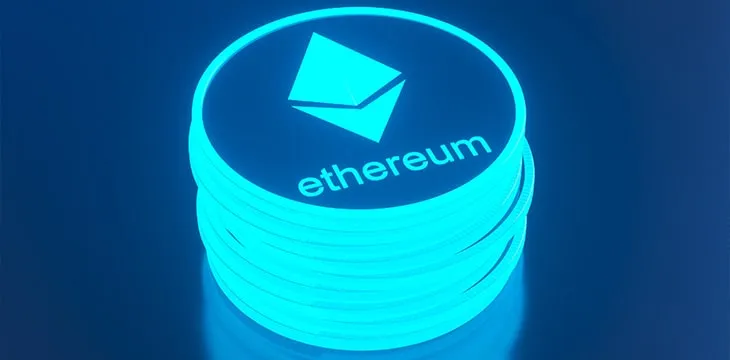|
Getting your Trinity Audio player ready...
|
They finally did it—Ethereum has switched its entire main network over to proof-of-stake (PoS) in an event called “The Merge.” The event, anticipated (and often delayed) for years now, was billed as the largest and most complicated open-source software transition in history. The live network, with a US$192 billion market cap and a claimed 90%+ share of the most valuable projects in the blockchain world worth over $60 billion, faces an uncertain future after it switched over to a new processing algorithm and economic incentive model today.
ETHEREUM TANKS AFTER SUCCESSFUL MERGER LAST DOWN -5%
— FXHedge (@Fxhedgers) September 15, 2022
So far there have been few signs of any major disruptions, although most online services suspended ETH deposits/withdrawals and DeFi services until The Merge completed. The big unknown now is whether proof-of-stake can retain the same level of trust and security as proof-of-work—and whether its large network of discarded PoW “miners” will rebel by maintaining a forked chain on the old network.
Staking reputations and incentives
ETH didn’t make any big moves on the trading markets. Its price has remained fairly flat for the past three months, having dropped from US$4,742 in November 2021 to $1,040 in July 2022. At press time, ETH was trading at around $1,488, down 6.8% over the past 24 hours.
Ethereum has been running a complex multi-layered network since 2020, designed to maintain a consensus between the new PoS system (called “Beacon chain”) and the old proof-of-work (PoW) execution-layer chain it’s been using since launching in 2015. From today, the two networks have merged (hence the name) and Ethereum will process all transactions using the staking model.
PoS has become a buzzword for blockchains wishing to project an environmentally friendly image, while PoW is frequently demonized for “wasting electricity” as miners compete to solve blocks. All miners consume the electricity, while only one actually does the block solving (and claims the block subsidy). However, there are strong arguments against PoS as an economic and security model, and questions over whether it could even affect the legal definition of PoS assets as securities. Instead of running mining machines, “stakers” commit a minimum 32 ETH by locking it away for a set time, and the algorithm picks a winner for each block. The more you stake, the more chance you have to claim the block subsidy.
This alters the network’s economic incentives significantly. With PoW, miners make substantial investments in expertise and physical infrastructure to keep the network secure. At a large enough scale, they also have real-world reputations to protect. PoS requires only that a staker locks some money away for a while—stakers’ real-world identities may remain unknown, as does the total size of the stake they control. Stake sizes and owners can also change quickly, and without being noticed. Since it’s virtually impossible to change physical mining dynamics in this manner, PoW provides more robust security and greater accountability.
The Merge also changes the way the total ETH supply is managed and issued. ETH is now issued only to validators, with new rules to stay on the network. There are penalties for stakers (called “validators”) who leave or go offline for long periods of time, or break other rules, which effectively “burns” some ETH. If this happens often enough, it will reduce the total ETH supply (currently 119,300,000 ETH).
Ethereum’s scaling headaches remain
The Merge and PoS mean the Ethereum network now claims a 99.9% reduction in energy consumption, making it far more marketable to the “carbon footprint” crowd. However, that wasn’t always its main selling point. Staking instead of mining was sold as the solution to Ethereum’s chronic network congestion and high-fee problems—issues that matter far more to projects actually running on the network. Now, some developers are noting it may not have much of an impact on scalability.
Cartoonist Rube Goldberg's artwork of a man using a self-operating napkin became a U.S. postage stamp in 1995. pic.twitter.com/oF8TbfZRrq
— Mark Pahlow (@mcpheeceo) June 28, 2021
Ethereum intends to solve the scalability issue at a later point, by “sharding” different aspects of its infrastructure into separate pieces. This creates yet more uncertainty for Ethereum and its $60 billion worth of “DeFi” projects. Whether those projects—which don’t necessarily have built-in loyalty to Ethereum and just need a functioning network—will have the stomach for more complexity and untried technology remains to be seen. They’ve already endured years of delays and hiccups as the switch to PoS stumbled along, and a lot will depend on how smoothly this next transition proceeds.
Then there’s the issue of whether Ethereum’s proof-of-work miners will react to being booted from the network. Suddenly left without an income stream after making large investments in hardware and energy, they will need to either find new blockchains to mine, or attempt to create a rogue Ethereum network known as ETHW, or ETHPOW.
COUNT DOWN STARTED!!!https://t.co/i5ndlFOZoi https://t.co/jGmglXK3EJ
— EthereumPoW (ETHW) Official (@EthereumPoW) September 15, 2022
ETHW has backing from some high-profile names, but it’s unlikely to gain a following to match Ethereum’s. As an example, Ethereum already has a hard-forked project called Ethereum Classic (ETC) that’s been running since 2016. Although it still has plenty of users and fans, ETC has nowhere near the public profile as ETH. Any PoW-based Ethereum network will still have to solve the old scaling and fee problems as well.
At the end of the day, Ethereum has cleared a major hurdle but it still has a long way to run. Meanwhile, Bitcoin (BSV) has proved it’s possible to run large-scale contract- and token-based data projects on a Layer 1, proof-of-work blockchain with unbounded scaling and transaction fees well under one US cent. The main question is whether serious projects will be attracted to a well-known name, or a blockchain that actually works.
Watch: The BSV Global Blockchain Convention presentation, Elas: Creating private, permissioned ledgers on the public blockchain

 09-01-2025
09-01-2025 




